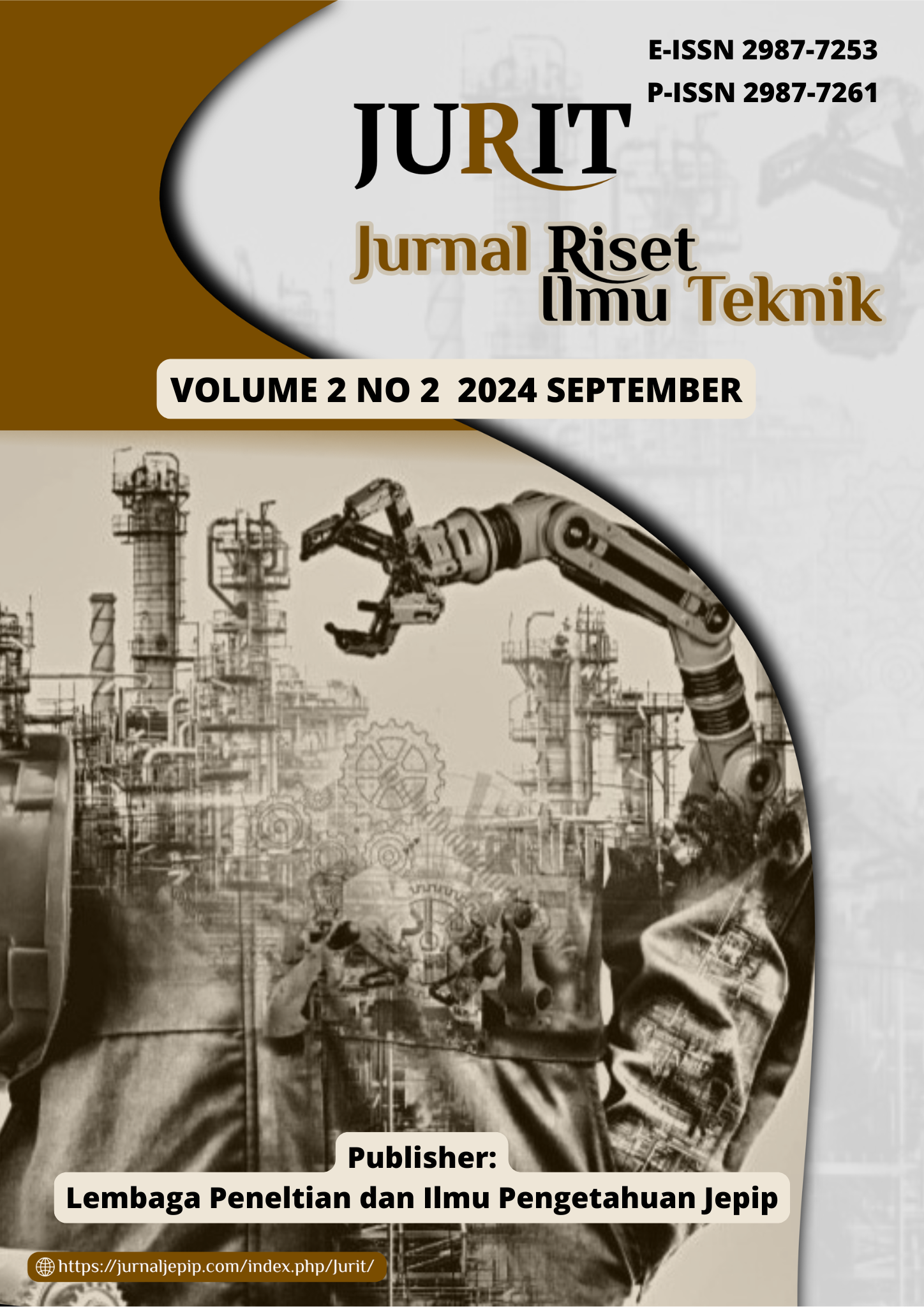Integrating Quality Function Deployment (QFD) In The Hygienic Oil-Draining Tools For Msmes: a Consumer-Centered Approach
DOI:
https://doi.org/10.59976/jurit.v2i2.118Abstract
Purpose – This study aims to design an oil-draining spinner tailored for Micro, Small, and Medium Enterprises (MSMEs) using the Quality Function Deployment (QFD) approach to ensure ergonomics, hygiene, and consumer-oriented innovation. Design– A quantitative descriptive design was applied, involving observations, interviews, and structured questionnaires with 10 MSME owners in fried food production. Consumer requirements were systematically translated into technical attributes through the House of Quality (HOQ). Reliability and validity testing were conducted, followed by concept screening and scoring to determine the optimal design. Findings – The results highlight that consumers prioritize minimalist size, multifunctionality, durability, and ease of cleaning. Correlation analysis revealed strong relationships between consumer needs and technical attributes, with system effectiveness and process stability being the most influential. Comparative evaluation of design alternatives identified a hybrid material combination of wood and heat-resistant plastic as the most feasible solution, offering balance between functionality, hygiene, and ergonomics. Practical implications – The findings provide MSMEs with a practical tool to improve food safety, durability, and competitiveness. The results also serve as a reference for policymakers in supporting MSME innovation through affordable, consumer-driven technologies. Originality/value – Unlike previous studies limited to prototypes, this research integrates consumer validation into QFD-based design, bridging gaps between technical feasibility and real-world MSME applications.
References
D. Neira-Rodado, “Smart product design process through the implementation of a fuzzy Kano-AHP-DEMATEL-QFD approach,” Appl. Sci., vol. 10, no. 5, 2020, doi: 10.3390/app10051792.
M. Li, “Integrating Kano Model, AHP, and QFD methods for new product development based on text mining, intuitionistic fuzzy sets, and customers satisfaction,” Math. Probl. Eng., vol. 2021, 2021, doi: 10.1155/2021/2349716.
N. Haber, “Integrating QFD for product-service systems with the Kano model and fuzzy AHP,” Total Qual. Manag. Bus. Excell., vol. 31, no. 9, pp. 929–954, 2020, doi: 10.1080/14783363.2018.1470897.
H. Reda, “Decision-making on the selection of lean tools using fuzzy QFD and FMEA approach in the manufacturing industry,” Expert Syst. Appl., vol. 192, 2022, doi: 10.1016/j.eswa.2021.116416.
L. He, “A novel Kano-QFD-DEMATEL approach to optimise the risk resilience solution for sustainable supply chain,” Int. J. Prod. Res., vol. 59, no. 6, pp. 1714–1735, 2021, doi: 10.1080/00207543.2020.1724343.
X. Wu, “A function combined baby stroller design method developed by fusing Kano, QFD and FAST methodologies,” Int. J. Ind. Ergon., vol. 75, 2020, doi: 10.1016/j.ergon.2019.102867.
S. Avikal, “QFD and Fuzzy Kano model based approach for classification of aesthetic attributes of SUV car profile,” J. Intell. Manuf., vol. 31, no. 2, pp. 271–284, 2020, doi: 10.1007/s10845-018-1444-5.
F. L. Lizarelli, “Integration of SERVQUAL, Analytical Kano, and QFD using fuzzy approaches to support improvement decisions in an entrepreneurial education service,” Appl. Soft Comput., vol. 112, 2021, doi: 10.1016/j.asoc.2021.107786.
T. Wu, “An interval type-2 fuzzy Kano-prospect-TOPSIS based QFD model: Application to Chinese e-commerce service design,” Appl. Soft Comput., vol. 111, 2021, doi: 10.1016/j.asoc.2021.107665.
C. Haiyun, “Analysis of the innovation strategies for green supply chain management in the energy industry using the QFD-based hybrid interval valued intuitionistic fuzzy decision approach,” Renew. Sustain. Energy Rev., vol. 143, 2021, doi: 10.1016/j.rser.2021.110844.
F. K. Gündoğdu, “A novel spherical fuzzy QFD method and its application to the linear delta robot technology development,” Eng. Appl. Artif. Intell., vol. 87, 2020, doi: 10.1016/j.engappai.2019.103348.
A. Karasan, “Customer-oriented product design using an integrated neutrosophic AHP & DEMATEL & QFD methodology,” Appl. Soft Comput., vol. 118, 2022, doi: 10.1016/j.asoc.2022.108445.
M. Z. Mistarihi, “An integration of a QFD model with Fuzzy-ANP approach for determining the importance weights for engineering characteristics of the proposed wheelchair design,” Appl. Soft Comput. J., vol. 90, 2020, doi: 10.1016/j.asoc.2020.106136.
H. Wang, “An integrated fuzzy QFD and grey decision-making approach for supply chain collaborative quality design of large complex products,” Comput. Ind. Eng., vol. 140, 2020, doi: 10.1016/j.cie.2019.106212.
I. Erol, “Alleviating the Impact of the Barriers to Circular Economy Adoption Through Blockchain: An Investigation Using an Integrated MCDM-based QFD With Hesitant Fuzzy Linguistic Term Sets,” Comput. Ind. Eng., vol. 165, 2022, doi: 10.1016/j.cie.2022.107962.
J. Wang, “Made in China 2025 and manufacturing strategy decisions with reverse QFD,” Int. J. Prod. Econ., vol. 224, 2020, doi: 10.1016/j.ijpe.2019.107539.
Y. Zhang, “An integrated hesitant 2-tuple Pythagorean fuzzy analysis of QFD-based innovation cost and duration for renewable energy projects,” Energy, vol. 248, 2022, doi: 10.1016/j.energy.2022.123561.
Y. Chen, “A new integrated MCDM approach for improving QFD based on DEMATEL and extended MULTIMOORA under uncertainty environment,” Appl. Soft Comput., vol. 105, 2021, doi: 10.1016/j.asoc.2021.107222.
W. Li, “Understanding the financial innovation priorities for renewable energy investors via QFD-based picture fuzzy and rough numbers,” Financ. Innov., vol. 8, no. 1, 2022, doi: 10.1186/s40854-022-00372-3.
L. A. Ocampo, “Integrated multiphase sustainable product design with a hybrid quality function deployment – multi-attribute decision-making (QFD-MADM) framework,” Sustain. Prod. Consum., vol. 24, pp. 62–78, 2020, doi: 10.1016/j.spc.2020.06.013.
S. Park, “Self-service technology kiosk design for restaurants: An QFD application,” Int. J. Hosp. Manag., vol. 92, 2021, doi: 10.1016/j.ijhm.2020.102757.
G. S. W. Finger, “A hesitant fuzzy linguistic QFD approach for formulating sustainable supplier development programs,” Int. J. Prod. Econ., vol. 247, 2022, doi: 10.1016/j.ijpe.2022.108428.
M. A. Gunduz, “Matching functions of supply chain management with smart and sustainable Tools: A novel hybrid BWM-QFD based method,” Comput. Ind. Eng., vol. 162, 2021, doi: 10.1016/j.cie.2021.107676.
X. Wang, “Technical attribute prioritisation in QFD based on cloud model and grey relational analysis,” Int. J. Prod. Res., vol. 58, no. 19, pp. 5751–5768, 2020, doi: 10.1080/00207543.2019.1657246.
M. Fargnoli, “Hazard function deployment: a QFD-based tool for the assessment of working tasks–a practical study in the construction industry,” Int. J. Occup. Saf. Ergon., vol. 26, no. 2, pp. 348–369, 2020, doi: 10.1080/10803548.2018.1483100.
J. Yuan, “Evaluating recognitive balanced scorecard-based quality improvement strategies of energy investments with the integrated hesitant 2-tuple interval-valued Pythagorean fuzzy decision-making approach to QFD,” IEEE Access, vol. 8, pp. 171112–171128, 2020, doi: 10.1109/ACCESS.2020.3023330.
W. Yang, “Effective radical innovations using integrated QFD and TRIZ,” Comput. Ind. Eng., vol. 162, 2021, doi: 10.1016/j.cie.2021.107716.
S. Huang, “The interval grey QFD method for new product development: Integrate with LDA topic model to analyze online reviews,” Eng. Appl. Artif. Intell., vol. 114, 2022, doi: 10.1016/j.engappai.2022.105213.
R. x. Nie, “Implementing healthcare service quality enhancement using a cloud-support QFD model integrated with TODIM method and linguistic distribution assessments,” J. Oper. Res. Soc., vol. 73, no. 2, pp. 207–229, 2022, doi: 10.1080/01605682.2020.1824554.
M. Yazdani, “A decision support model based on the combined structure of DEMATEL, QFD and fuzzy values,” Soft Comput., vol. 24, no. 16, pp. 12449–12468, 2020, doi: 10.1007/s00500-020-04685-2.
S. Altuntas, “An innovative and integrated approach based on SERVQUAL, QFD and FMEA for service quality improvement: A case study,” Kybernetes, vol. 49, no. 10, pp. 2419–2453, 2020, doi: 10.1108/K-04-2019-0269.
F. Khan, “A new fuzzy FUCOM-QFD approach for evaluating strategies to enhance the resilience of the healthcare sector to combat the COVID-19 pandemic,” Kybernetes, vol. 51, no. 4, pp. 1429–1451, 2022, doi: 10.1108/K-02-2021-0130.
M. B. Kumar, “A comprehensive model to prioritise lean tools for manufacturing industries: A fuzzy FMEA, AHP and QFD-based approach,” Int. J. Serv. Oper. Manag., vol. 37, no. 2, pp. 170–196, 2020, doi: 10.1504/IJSOM.2020.110337.
M. Pandey, “Evaluating the strategic design parameters of airports in Thailand to meet service expectations of Low-Cost Airlines using the Fuzzy-based QFD method,” J. Air Transp. Manag., vol. 82, 2020, doi: 10.1016/j.jairtraman.2019.101738.
H. Elhegazy, “Implementing QFD in decision making for selecting the optimal structural system for buildings,” Constr. Innov., vol. 21, no. 2, pp. 345–360, 2021, doi: 10.1108/CI-12-2019-0149.
A. E. Torkayesh, “Analysis of industry 4.0 implementation in mobility sector: An integrated approach based on QFD, BWM, and stratified combined compromise solution under fuzzy environment,” J. Ind. Inf. Integr., vol. 30, 2022, doi: 10.1016/j.jii.2022.100406.
P. Duan, “Root cause analysis approach based on reverse cascading decomposition in QFD and fuzzy weight ARM for quality accidents,” Comput. Ind. Eng., vol. 147, 2020, doi: 10.1016/j.cie.2020.106643.
N. Aydin, “A linear programming-based QFD methodology under fuzzy environment to develop sustainable policies in apparel retailing industry,” J. Clean. Prod., vol. 387, 2023, doi: 10.1016/j.jclepro.2023.135887.
X. Chen, “A decision support model for subcontractor selection using a hybrid approach of QFD and AHP-improved grey correlation analysis,” Eng. Constr. Archit. Manag., vol. 28, no. 6, pp. 1780–1806, 2020, doi: 10.1108/ECAM-12-2019-0715.
A. Fetanat, “Sustainable design of the household water treatment systems using a novel integrated fuzzy QFD and LINMAP approach: a case study of Iran,” Environ. Dev. Sustain., vol. 23, no. 10, pp. 15031–15061, 2021, doi: 10.1007/s10668-021-01284-5.
Downloads
Published
How to Cite
Issue
Section
License
Copyright (c) 2024 Damas Aulia Nata, Hamdan Hamdan, Ryando Rama Haiban

This work is licensed under a Creative Commons Attribution 4.0 International License.





















